‘It Smells Like Earth’: Inside the Eco-Minded World of Human Composting
- Oops!Something went wrong.Please try again later.
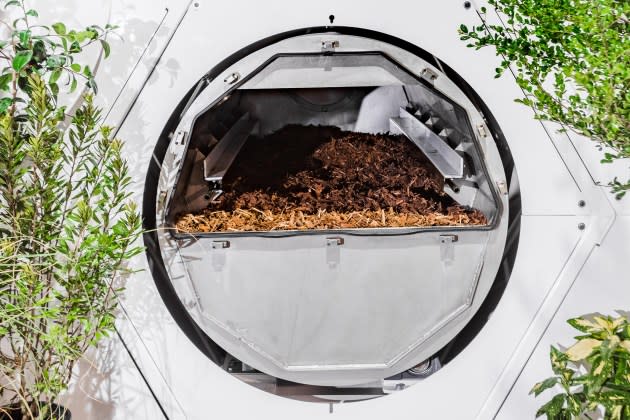
In the warehouse-huge back room of his company Return Home, just south of Seattle, Micah Truman walks over to what looks like an off-white shipping crate, complete with a lock on the front. “Put your hand onto it,” instructs Truman, who, with his woodsy vest and tidy appearance, looks like a genial banker on a hiking tour.
The machine is warm to the touch. “They’re running 140 to 150 degrees,” he says approvingly. “The magic number is 131 degrees for 72 hours. Gets rid of all your baddies. Your viruses. I don’t want someone opening one of these vessels until that person is transformed.” You heard that correctly. Inside that cylinder is a deceased person, and Truman is referring to the brave, and surprising, new world of what the pros call natural organic reduction (NOR) — or, as it’s more commonly referred to, human composting.
More from Rolling Stone
How a Blog Turned Record Label Changed the Face of Electronic Music
'Eternal You': A Horrifying Doc About AI Companies Recreating the Dead
For tens of thousands of years, disposals of human bodies have largely been by burial or cremation, with the latter particularly on the rise. In the last couple decades, thanks in part to heightened concerns about the impacts of those procedures on the environment, a few offbeat additions have joined the list. In water cremation (or alkaline hydrolysis), a body is submerged in a vessel filled with water and potassium hydroxide, which effectively dissolves it over the course of about a day. Or the deceased can be donated to what are called “body farms,” where they can decompose naturally and medical students can pick over the remains to study the process. Or, if you’re in the market for something more tangible, cremated remains can be turned into decorative stones.
Depending on your religion, views on the environment, or degree of squeamishness, none of those options quite boggles the mind as much as human composting. Details vary by company, but here’s what that means: After you die, your body will be washed and covered in a mixture of wood chips, alfalfa, flowers, and/or straw, which injects carbon into the mix and balances out the nitrogen in your body. You will then be placed inside a machine like Truman’s, where you will instantly heat up, then cool down. Air will be pumped in and microbes will start doing their work.
In about a month, depending on your weight, the door to the vessel will be opened. Bones will be ground into small particles and any gold tooth or metal plate will be pulled out and recycled or trashed. What remains will be a cubic yard of soil — part you, part ingredients, enough to fill the back of a pickup truck. “A lot of people don’t realize the science behind it,” says Josh Forbes, head of operations for Earth, a facility less than a mile away from Truman’s. “They think of composting like kitchen composting. And that’s obviously not what this is.”
Some have treated the NOR movement with disbelief and shudders — or, as those who work in it well know, compared it to the 1973 movie Soylent Green, set in a future where the deceased are ground up and made into food to compensate for an overpopulated planet. But the movement isn’t simply a novelty; it’s also a window into how different generations look at climate change. And if enough people can overcome what’s known in the NOR business as the “ick factor,” maybe it can help rescue the planet, one mound at a time.
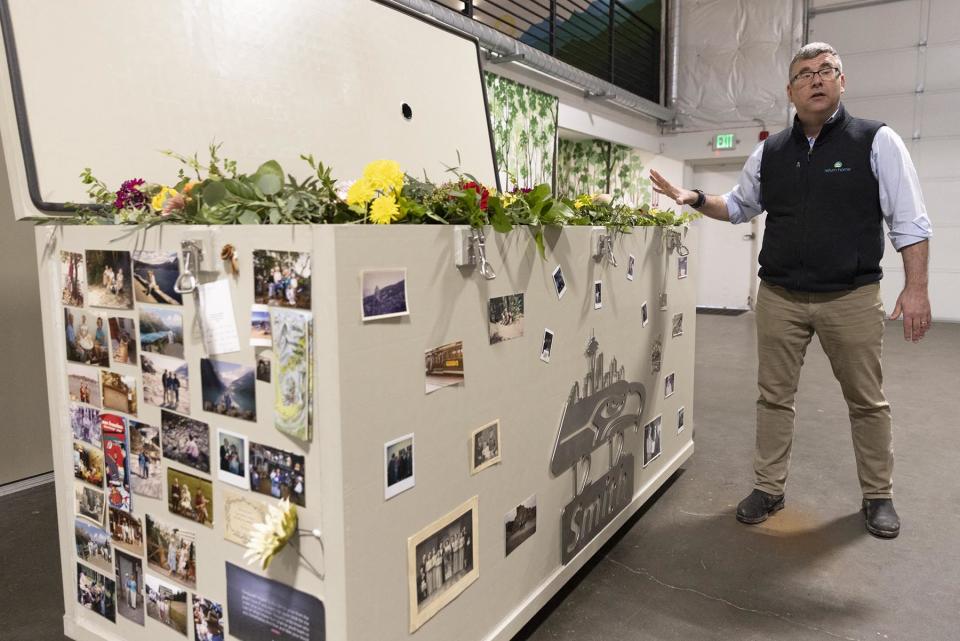
The temperatures on his vessels in good shape, Truman perks up. “We’re done with your d’oeuvres,” he says, signaling his dual roles as passionate (and compassionate) NOR advocate and eager ringmaster with a sense of humor. (A furrowed brow gives way to an impish grin and one-liner.) “Now we’re going to the back of house,” he says, “and I’m going to take you step by step with every ingredient.”
KATRINA SPADE REMEMBERS HOW it all began. About a dozen years ago, when she was enrolled in the Master of Architecture program at UMass Amherst, she watched her son, Kale, then three, rolling around in the grass and doing somersaults. “I was basically thinking, ‘I’ll never be that young again, and he’s growing so fast,’” she recalls. “I just had this moment of mortality. I was just like, ‘Holy shit. When he’s 40, I’ll be 70.’ So I started thinking, ‘Okay, what would I do with my body? What will my family do?’”
Spade, a tall, slender and earnest 46-year-old in tan slacks and sweater, is recalling that moment in the office of her NOR company, Recompose. Located in Seattle’s industrial district, the building — a full-service funeral home and human composting facility — has a folksy front porch with cheery paintings of leaves, next to a garden with a small path winding through it. Spade cheerily admits that some of her company’s work is part of that garden. “A couple of weeks ago!” she says. “It was a person whose dad had died and asked if we could spread some soil in the garden. And we said, ‘Absolutely!’”
The NOR movement is now legal in eight states: Washington, Colorado (home to the Natural Funeral, the only other such facility in the country at the moment), Oregon, New York, Vermont, Nevada, Arizona and California, where it doesn’t go into effect until 2027. Lobbying efforts are underway to legalize it elsewhere, with growing success: Delaware is on the verge of making it law, and a bill is under consideration in Minnesota. But Washington, where most of the current NOR facilities are located, was the first state to turn it into law. With three human composting companies in Seattle and nearby Auburn, it’s become the Silicon Valley of the human composting movement.
That’s all thanks to Spade, who’s taken on a role as the approachable face of the movement. Growing up in New Hampshire, the daughter of a doctor and a physician assistant who both enjoyed gardening, Spade was immersed in life, death, and non-human composting early on. One of her early household chores was mulching. “I’m not saying composting was directly responsible, but I started to appreciate the process of it,” she says. “You’re transforming something in a pretty short amount of time from one being to another.”
After college, Spade worked a variety of jobs, from co-founder of a T-shirt company to finance manager at a San Francisco nonprofit, before she returned East, first to Vermont and then Northampton, Massachusetts. At UMass Amherst, she heard about farmers who composted animals. Egged on by her own thoughts of mortality after that moment with her son, she wondered if it could be applied to people. “They were saying, ‘Find something that interests you,’” she says. “Well, I’m interested in our bodies and why all we have is cremation, which seems just kind of wasteful.” Her thesis, Of Dirt and Decomposition: Proposing a Place for the Urban Dead, built on that idea. In 2014, she obtained a grant from Echoing Green to further study alternatives to burials and cremation, which led to her founding a nonprofit she called the Urban Death Project (UDP), dedicated to burial options for those, like Spade, who lived in cities.
As Spade and others in her particular field came to learn, the most dominant means of body disposal are also accompanied by harmful side effects on the planet. According to studies compiled by the Green Burial Project, a nonprofit that established guidelines and environmental standards for the movement, casket burials result in more than 870,000 gallons of formaldehyde seeping into the ground a year, and that doesn’t include all the wood, metal and concrete used for caskets. Cremation, they say, isn’t much better — each one releases more than 500 pounds of carbon dioxide into the air, the rough equivalent of driving 500 miles. A 2022 study by the scientific journal Chemosphere determined that a traditional burial “generates several potential contaminants capable of dispersing to the urban and environment,” with possible links to liver disease, lung cancer, and issues with the central nervous system.
Our increasingly atheistic society also factors in, as does our mobility. “We live in a very transient society,” says Tom Harries, co-founder of Earth. “People do not live where they grew up, and therefore people don’t really want headstones that no one ever goes to visit.” Jewish law and certain religious organizations, like the Catholic Church, aren’t in favor of the process, but the way Americans are growing more secular and less religious plays into the appeal of NOR, too.
In 2015, Spade connected with Cheryl Johnston, a forensic anthropologist who ran a body farm at Western Carolina University. Testing out an early version of Spade’s approach, they placed the donated body of a man atop a pile of wood chips and some alfalfa in a forest, then relied on time and aeration to do the work. (Alfalfa, Spade says, recreates “works biologically and also smells great.”) It took several months for the body to turn into a type of compost, but two years later, Spade grew even more serious.
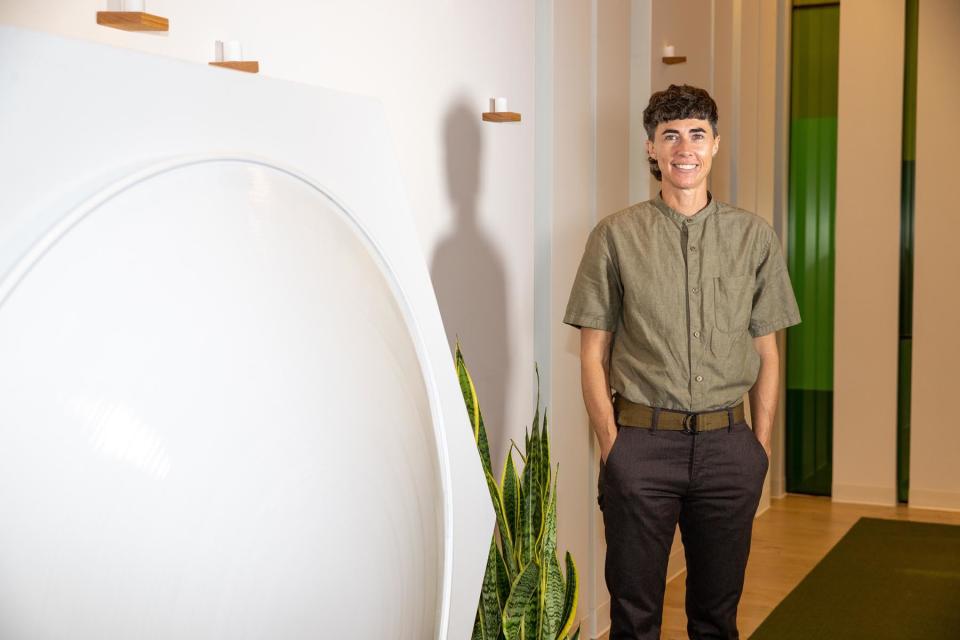
By then, she and her family had moved to Seattle, and in 2017, she’d changed the name of her company to Recompose. (“Urban Death Project was pretty to the point,” she says. “But it was like a metal band.”) Spade hooked up with the soils science department at Washington State University, a program that works exclusively with livestock composting. Using a vessel similar to what she and others would eventually build for their NOR businesses, Spade and her associates conducted tests on six bodies. (The process wasn’t yet legal, but they were able to conduct those early trials thanks to the legal practice of participants who’d donated their bodies to science.) During those trials, Spade had several “eureka moments,” she says, such as realizing that human composting breaks down the pharmaceutical remnants in the body: “So what you have, in the end, is this beautiful material you can use safely on plants and trees.”
Moving to Seattle also provided what Spade calls “a bit of dumb luck.” The fact that Spade was, in her words, “a random queer lady” didn’t hurt in terms of feeling she was left to her own devices, and the city, with its history of progressive movements and lifestyles, didn’t seem to flinch at her proposal. “Seattle is a little dark, in some ways,” she says. “We have grunge and everyone sees themselves as like not everyone. The city has seen itself as alternative, and a bit more welcoming to someone of that alternative stuff.”
In 2018, Spade began the process of legalizing her new profession, enlisting Democratic State senator Jamie Pedersen. Along the way, Pedersen heard a gamut of responses to NOR. “You can imagine that could creep some people out,” he says, recalling reactions that ranged from, in his words, “Oh, wow, that’s really cool” to “yuck, I don’t want to talk about it.” But he too was lured in by the environment aspects, calling the use of land for cemeteries “not sustainable.” In 2019, the bill passed, by a sizable margin, and was signed into law by Governor Jay Inslee. The following year, Recompose opened for business, and the human composting gold rush was on.
AFTER OPENING A PRELIMINARY office, Spade’s Recompose eventually settled into its current location. But the company wouldn’t have the market to itself for very long. In 2020, Truman launched Return Home, followed that same year by Earth, run by Harries, a Brit who helped innovate the cremation business by making the process available online. “That didn’t take long,” Spade says, with a bemused smirk. “On a movement level, it’s really good. If more people are doing it, it’s becoming accepted. But otherwise it took me a minute.”
The companies began attracting refugees from the traditional funeral world, like Katey Houston, Return Home’s services manager. When she was approached by Truman, Houston, who’d spent 15 years working in funeral homes, realized she would no longer have to embalm, only bath the bodies and close their eyes and mouths. “Formaldehyde isn’t burning my nose and eyeballs every day,” she says. “My hair is not falling out from the crematory.”
Beyond their basic missions, the businesses have certain aspects in common. Each charges in the ballpark of $5,000 to $8,000, still less expensive than a burial or cremation, which can be upwards of $10,000. Each is located on a cul-de-sac dominated by warehouses and office buildings — which, in the case of Earth, wasn’t necessarily a first choice. “People are wary of new processes,” says Harries. “Landlords don’t typically love death-care companies. We weren’t inundated with options.” The space they’re in, a former Boeing supply warehouse, was, he says, “pretty beaten up” when they took it over and opened in 2022. “It wouldn’t have been our first choice,” he says, “but ended up being our only choice.”
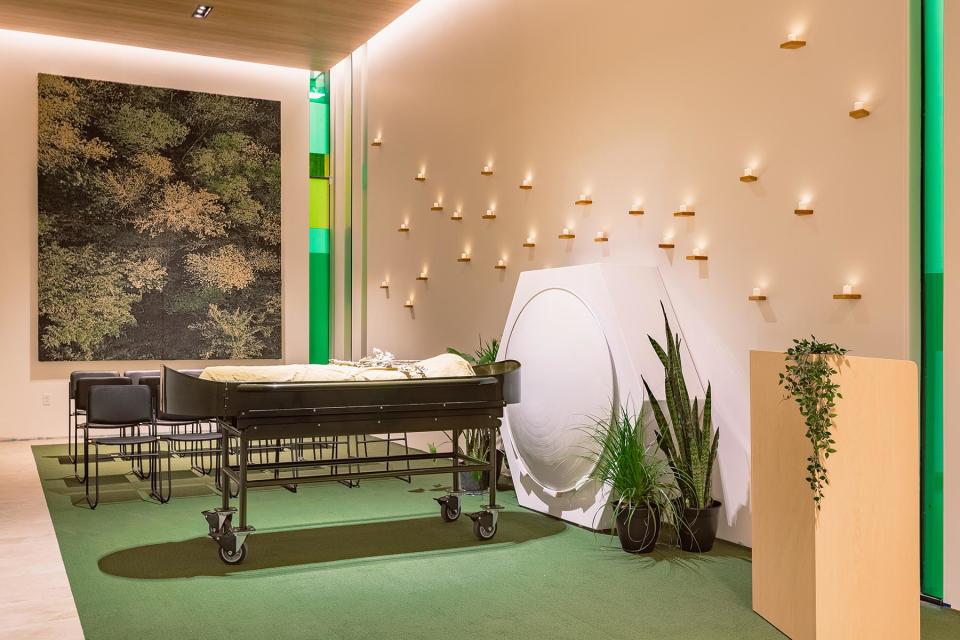
Once you step inside each of the Washington State facilities, other aspects look familiar. Just beyond Recompose’s front desk is a space that resembles a chapel, where relatives and friends of the deceased can gather, say their farewells, and apply some of the company’s ingredients over the shrouded body. In the next room lies the “greenhouse” containing a wall of what resemble white stacked washer-dryers. Inside each is an eight-foot-long stainless-steel vessel, where a body is laid atop Recompose’s combination of wood chips and alfalfa, then covered again. (Like Truman, Spade also aims for the 131-degree range, inspired by livestock composting.) “The door is closed,” she says, “and that’s the last time that person is in that form.” Earth has a similar area for services and what also resembles the world’s largest laundromat, with a total 78 vessels.
But there are differences, starting with what Spade calls “the recipe.” Recompose and Earth each use wood chips for composting; Recompose adds in straw alfalfa, and Earth uses organic mulch and wildflowers. Truman, who prefers an alfalfa-and-sawdust cocktail, isn’t sold on his competitors’ blend. “We think chips are problematic,” he says. “You need insulation, a nitrogen source and absorption. I don’t know what the hell wood chips do. If liquids are going through them, how do they absorb? Where does the liquid go?” (Counters Spade: “Wood chips are used pretty frequently, if not almost all the time, for agricultural composting of livestock. They’re an excellent carbon source.”)
Born in the United States to an American U.N. diplomat, Truman moved to Kenya as a child and lived in China for much of his adult life, eventually working as an investment capitalist. Hearing about Spade and her work, and after a conversation with his mother and her friends about whether they were open to the process, Truman found his calling: “I worked in finance. It wasn’t like this. I’m 52 and I never did anything that mattered.” He began putting out calls to animal composters to see if they could include humans. “They said, ‘No sweat. We can totally do that with people. We’ll cover the bodies in nitrogen-rich gunk and stack them and run air and insulate,’” he recalls. “And I was like, ‘How about we don’t do that?’”
Working with a non-human composting company in Canada (where NOR is not legal), Truman and his coworkers decided to build a different machine for each step of the process. While Recompose and Earth use all-in-one vessels that gently rotate the mixture, Return Home employs a giant praying-mantis-type device that shakes and rotates the blend of body and ingredients. After that process is complete, a machine grinds up the bones, and another plucks anything non-organic —”stents, screws, and breast implants,” says Truman, pointing toward that area — from the mixture.
Finally, Truman arrives at the last stop in the back — a large gray canister that looks like a dumpster. Truman might have a self-aware goofy side to him — “We’re Colonel Sanders,” he says, referring to the particular mix of ingredients his company uses —but he’s also deadly serious about his business. Inside the container is a rich, dark brown mulch that’s moist to the touch and ever so slightly grainy. He beams with pride at the composite of human and ingredients before him. “Isn’t it cool?” he smiles. “It’s kind of wild. It smells like the earth.”
BY THE TIME SHE CARPOOLED home from work in February 2023, Jasmine Eustaquio, a painter at the Puget Sound Naval Shipyard, was already curious about human composting; she’d come across a video on YouTube and was hooked. But on the ride home, the car hit an icy patch and almost slammed into a tree. “It was the first time I had that little scare,” says Eustaquio, 30. “I was thinking, ‘Man, if I were to die right now, what would I want to happen to me?’ I just thought, ‘I want to be composted.”
This past February, the first conference devoted to NOR, TerraCon 2024, was held in Tacoma, Washington, attracting human-composting companies, funeral directors and family members who’d paid for the process. Seth Viddal of the Natural Funeral in Colorado, which also does traditional burials and cremations, says human composting is approaching 40 percent of its business. But what’s also called the terramation industry isn’t yet pulling in major dollars. Since these companies have opened, they’ve each composted in the hundreds of people, with as many as 1,500 on waiting lists, but not all are profitable. Last fall, Truman pitched his product on Shark Tank and, after asking for a $2 million infusion, was turned down after announcing Return Home was a “money-losing company.” “If I had five bucks for every Soylent Green [joke]” Truman says, “we would be profitable.”
The future of the business may well be the young; some NOR companies claim that a percentage of people signing up for their services are millennials and younger. Eustaquio chose Earth partly for the financial aspect; she wouldn’t want her family to be burdened with the high cost of a burial or cremation. But the environment also factored in. “Nothing has to get buried, right?” she says. “You don’t need to get a big fancy box. I’m not putting any harmful chemicals into the ground. A lot of energy isn’t done to burn you. I can’t say I’ve always been like a super champion of being environmentally friendly. But to me it is something that’s important.”
Matt Baskerville, an Indiana funeral director and member of the National Funeral Directors Association, confirms that his older customers are far less enchanted with the idea than younger ones. When the composting idea comes up with what he calls his “traditional” clients, he says, “I get a lot of unpleasant looks on faces. The parents may or may not be exactly too well received of the concept, but it certainly draws the attention of the younger crowd.”
Baskerville’s boomer customers aren’t the only ones who remain skeptical of the idea. Early this year, Heather Scott, a Republican representative in Idaho proposed expanding the state’s definition of cannibalism after hearing about human composting, fearing the mixture would somehow make its way into the food chain. (“This is going to be normalized at some point, the way our society’s going and the direction we’re going,” she said.) The funeral industry, a $20-billion-annual business, isn’t completely sure what to make of it either. At a conference in Washington State a few years ago, just as Return Home was preparing to open, Truman was seated at a table with funeral directors. “They just said, ‘You are disgusting,’” he recalls. “I’m like, ‘You guys are embalming. I mean, cut me some slack, you know?’ We’re held to a different standard. It’s hard for people to see a new world.”
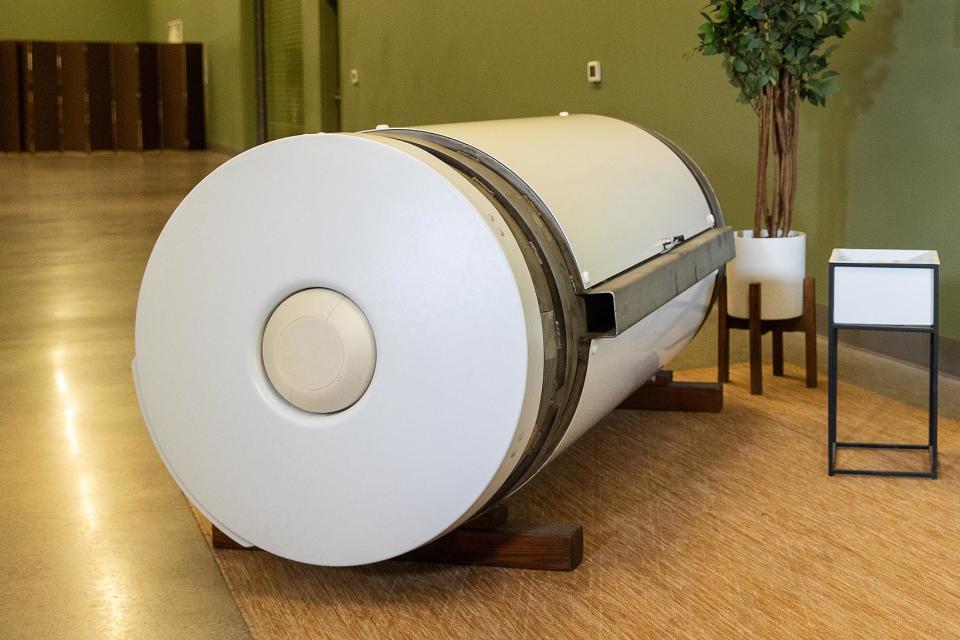
Baskerville has heard such grumblings, and, in his jovial way, questions the environmental impetus for this alternative method. “At the end of the day, I don’t believe there’s really any true 100 percent eco-friendly green [burials], unless you’re hand-digging a grave, washing and shrouding a body, and placing a body into the soil,” he says, adding, “They’re still using power for their facility. You take all those factors and it’s not one hundred percent [green].” But he also says that his business, initially wary of human composting, has taken steps toward cooperation: In the future, services could still be held in those facilities before a body is shipped to a company like Recompose.
The Catholic Church, meanwhile, is praying for the end of the NOR movement. In March 2023, the United States Conference of Catholic Bishops (USCCB) issued a statement on what it called “the proper disposition of bodily remains.” Feeling as ever that a body must remain intact so that souls and bodies can be reunited, the USCCB generally approved of cremation but condemned NOR, calling it “disconcerting” that “there is nothing left but compost, nothing that one can point to and identify as remains of the body.” When a human composting bill came up in Illinois last year, it failed to pass in the Senate, especially once the Catholic Conference of Illinois came out against it; according to the bill’s sponsor, Representative Kelly Cassidy, there was also pressure “behind the scenes by the cemetery industry.” Perry expects the bill will come up for another vote in the weeks ahead.
Spade is aware of the Church’s opposition. “They were like, ‘It’s like considering the body as waste,’” she says. “What else do we do with waste? You burn it, we incinerate it, and we bury it in landfills. I’m not saying that humans are waste at all. But I am saying that cremation and burial are no more special than what we’re proposing.” In Washington state, Pedersen says he received a letter from the Church asserting its opposition to the initiative, although the protest ended there. “The Catholic Church’s perspective was that it’s not dignified,” says Pedersen. “Is it really dignified to drain people’s blood out and pump them full of formaldehyde? Is it dignified to dump them into a furnace and incinerate them at 1,800 degrees? This [NOR] seems to me to be a very dignified natural process.”
For others, like Paul Sheck, neither the environment nor any religious beliefs came into play when the time arrived to say goodbye to his son Jacob. Just as he was starting college, Jacob was diagnosed as schizoaffective, experiencing both mood disorders and manic periods. Turning to drugs, he was hospitalized and wound up in a program in California; last year, he died from an accidental overdose. Pulling out his phone, Sheck, who runs a financial trading company that specializes in sporting goods and raw materials, calls up photos of Jacob at various stages in his life, from his carefree, pre-diagnosis teenage years to later shots where he seems in the grips of mental health issues. “Jacob had these moments where he was well and insightful,” Sheck says. “But schizoaffective is a beast. For Jacob it was really a beast.”
Given how troubled Jacob had been, the last thing Sheck wanted to do was place him in the ground, alone. “I could not put him below my feet,” he says, firmly and yet with evident pain in his voice. “I couldn’t imagine standing at a gravesite and lowering him into a grave. I would feel like I was abandoning him.” By the time Jacob died, Sheck had already signed up with Recompose for himself, and after conversations with his family, he decided to return his own son to the earth by way of Spade’s company. “This idea of a return to nature is deeply beautiful to a parent who’s lost a child,” he says. “I don’t feel that way about cremated ashes. I don’t feel that way about burial.”
Flying out to Seattle from New York, Sheck participated in the ceremony. When six containers with Jacob’s remains later arrived at his home, Sheck opened one. “The soil is beautiful,” he recalls. “It smells earthy. It feels alive. I just dug my arms into him.”
Recompose has partnered with nonprofit conservation organizations who oversee plots of land where soil can be donated — where families can, if they so choose, distribute some of the soil of their loved ones. For Recompose, one of those partnered areas is Vashon Island in nearby Puget Sound. Sheck has kept containers of Jacob’s soil in his homes in New York and Connecticut, where he hopes to place some of his son’s remains at a memorial tree. In the meantime, he is planning to visit Vashon Island, where Jacob’s remaining soil was delivered in January, as often as possible. “It’s death, and there are no good alternatives here,” Sheck says. “I wish he weren’t dead. I’d give anything. But given the universe of alternatives, he’s propagating new life. What can be more beautiful than that? It rains on him, and things grow from with him. And under the circumstances, I’ll take it.”
AS TRUMAN AND HOUSTON TALK about the history of Return Home in the company’s conference room, two visitors pass through. Laura and her mother Elizabeth are saying goodbye to Lyle, Laura’s brother and Elizabeth’s son, who is being composted in the next room.
When Truman first conceived of Return Home, he didn’t envision it as open to the public, but soon changed his mind. Large, floor-to-ceiling tapestries of forests are now draped alongside the vessels for a sunnier, less drab atmosphere, and families are invited to sit next to one of the warm vessels containing their loved ones during the composting period. They can visit as many times as they like, decorate the vessels in any way they choose and invite as many family members as they desire. “It’s a system akin to a brew pub,” Truman says. “Which I know sounds kind of weird. At brew pubs, they make it in a way that you can go have hors d’oeuvres with your friends and have a really nice time. We’re not exactly the same, ethos, but the theory carries.”
After Lyle passed away from a heart condition, Laura began calling around to local funeral homes and was dismayed by the way she was passed around to different departments. When she and her family heard about composting, they were drawn to it along with the companies’ smaller, more hands-on staffs and the idea itself. “It’s the slower process, the more natural process that we can still be a part of,” Laura says. “It’s not like a solemn funeral home or standing outside in the rain around a dirt hole.”
Two chairs and cushions are placed in front of Lyle’s vessel so family can sit with him. Laura loves that they were able to place notes inside the vessel and even likes the word vessel itself — “instead of casket or urn,” she says. She also takes comfort in the fact that Lyle, who worked in IT, would have loved being on the forefront of new technology.
“You guys had the best freakin’ service,” Truman tells them, reassuringly. “It was so good.”
The human composting companies have heard all the stories about what families do with the soil once it’s handed to them. There was the girl who died at seven; since she loved bees, her mother dispersed the mixture to friends in 100 small bags for plants that would attract and feed bees. Other families have embarked on road trips to national parks, scattering a bit of soil in each one. (“Which, as long as you confirm with park rangers, that’s totally fine,” says Forbes.)
Leaving behind the handful of photos and sweet letters attached to Lyle’s vessel, Laura and her mother tell Truman they’ll be back soon. Once the process is complete, they’re warmed by the thought that Lyle will be all around them, in what his mother calls “in our gardens, flowers and trees.” Adds Elizabeth about what awaits them, “I get this soil. People can have some and grow things in it. And his DNA is in that soil.”
Best of Rolling Stone

